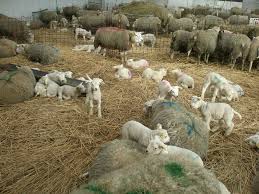Natural heath we find on poor soil above the tree line in the mountains and to the sea borders.
Our heath is a cultural landscape created by people. The oldest moors originated some 5,000 years ago on nutrient-poor soils.
 The first farmers set forest on fire to get (fire culture) arable land. Or uprooted trees to make charcoal (for production of tar, iron, blacksmiths...).
The first farmers set forest on fire to get (fire culture) arable land. Or uprooted trees to make charcoal (for production of tar, iron, blacksmiths...).
In the ashes and the fertile top layer of the wood grain was sown. The soil was exhausted after three years. But there was plenty to cultivate (rotation) a new plot. And nature took care of reforestation. On sandy soils, nature cannot keep up. There grew only small shrubs: heather and some herbs and grasses.
To make fields fertile were (mostly) kept sheep for their manure. They lust heath and eat saplings. This faded the forests for the benefit of the moors. Naturally heath is a light -loving pioneer plant, which in time will be supplanted by trees.
In the evening the sheep were driven to the deep litter (sometimes without roof). The objective was to have some protection against wind and weather, to keep the flock together but also to collect valuable manure. Manure was arranged with dry material (straw, sod (top layer of the soil), heather, peat) sprinkled to keep the animals clean. This created a tightly joined, warm and thick layer of manure that later after maturing outside in heaps was used in the fields.
An ‘es’ (also called camp) is a spherical field located high on poor sandy soils. The small, square or rectangular plots (80 to 120 meters long) with a surface area of 0.75 to 1.5 hectares were surrounded by an eswall. This game dig or wild wall had to keep out game and livestock and avoid spray of the fertile ground.
The wooded bank was formed by the accumulation of slowly decaying branches and trunks along the field. The wall sides were sometimes immediately planted with shrubs as hedge.
The fertilizing sods were initially cut out and supplied from the stream valleys. Later these turfs were enriched (and increased) with the content of the deep litter. The oldest es and es villages descend from 500 to 1,000 years ago.
The many disordered plots were over time made workable by regulations for all members of the village community and the collective. Because they often had to travel across each es there were obligations on crops to which one should work the land at the same time to sow and reap.
Wool and meat were only byproducts. To keep in the Kempen 1 ha field arable fertile enough, with deep litter manure, there were needed 10 to 16 hectares of grazed moorland.
A decomposing, brooding layer of manure produces, like a compost heap, also heat. That can be a bonus in winter.
A specific activity on the heath was beekeeping.
Buckthorn (Rhamnus frangula) flowers not one moment, but continues over a longer period forming racemes which are also very sweet. Therefore, the buckthorn on the moor was a valuable tree to farmers. Byond the heyday of the heather bees were able to stay on foraging on them.
At the end of the nineteenth century chemical fertilizer put an end to the deep litter system. Agriculture was no longer dependent on the heath. And sheep farming in Australia showed much cheaper than in Europe by which sheep flocks were shut down here. The better plots heath became fields and lesser plots were planted with coniferous wood that was used in the mining industry.
Heath is overgrown by two grasses, the Purple Moor Grass and wavy hairgrass. Birch, pine (and black cherry) start the reforestation. To maintain moors so human interventions remain necessary: cutting sods, mowing, burning and /or grazing. As a result, nutrients are extracted from the ground. Thus, the bottom remains nutrient poor, which is favorable for the growth of heather species.
Difference heath - heather
You recognize heath if you take into account that these evergreen dwarf shrub should be resistant to dehydration. The stomata (breathing pores on the leaf) are in deep grooves that additional
are protected by hair. In winter they fold the leaves as much as possible. The young twigs are hairy too.
|
Heath (Erica tetralix) |
Heather (Calluna vulgaris) |
|
|
species |
+- 600 (mainly S- Africa) |
1, in Europe |
|
occurrence |
rarer |
|
|
ground |
moist |
dry |
|
flowers |
close together at the top, hanging |
all over the twig |
|
greater |
||
|
flowering |
earlier, June-July, Aug blooming |
later (July to Sept): Summer heather |
|
leaves |
needle-shaped in whorls of three or four |
scale shaped |
|
young twig |
hairy |
bare |
|
leaf implantation |
whorls |
opposite, 4 rows (roof tiles) |
|
height |
40 cm (max. 100) |
even meters tall, woody, broom equipment (broom heath) |
|
typically accompanied |
moor grass (Molinia caerulea), round -leaved Sundew (Drosera rotundifolia), Gale (Myrica gale), marsh gentian (Gentiana pneumonanthe), asphodel (Narthecium ossifragum). |
wavy hairgrass (Deschampsia flexuosa), broom (Cytisus scoparius), juniper (Juniperus communis). |
